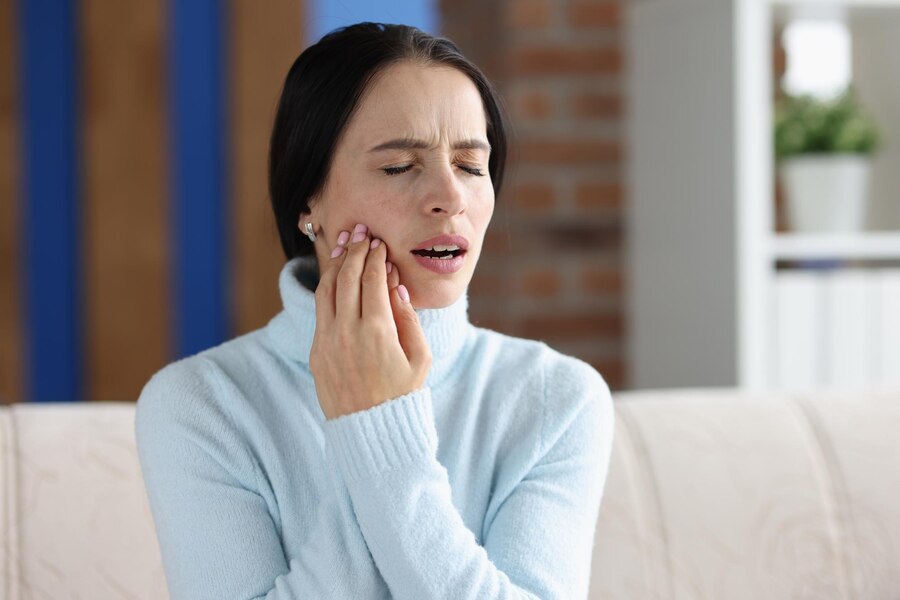Temporomandibular joint (TMJ) dysfunction manifests through pain, stiffness, and difficulty with jaw movement.
Dry needling for TMJ-related pain is one of the approaches that healthcare providers and patients explore to manage and alleviate discomfort and restore function.
Let us understand the connection between TMJ dysfunction and dry needling therapy as we uncover that which holds promise for individuals seeking effective relief from their symptoms.
Understanding TMJ Dysfunction
Situated on each side of the face, the temporomandibular joint acts as a pivotal hinge connecting the jawbone (mandible) to the skull’s temporal bone. This joint facilitates essential movements for chewing, speaking, and yawning. It comprises the articular disc, ligaments, muscles, and synovial fluid.
The articular disc cushions between the mandible and the temporal bone; the ligaments surrounding the TMJ provide stability and support; a network of muscles, including the masseter and temporalis muscles, work harmoniously to enable jaw movement.
Temporomandibular joint (TMJ) dysfunction can manifest due to the following factors:
- A direct blow to the jaw, whiplash, or other forms of trauma or injury.
- Habitual clenching or grinding of the teeth (bruxism) especially during sleep.
- Misalignment of the teeth or bite (malocclusion).
- Degenerative joint diseases such as osteoarthritis or rheumatoid arthritis.
- Psychological factors such as stress and anxiety.
Its symptoms include:
- Persistent or intermittent pain in the jaw joint area, often exacerbated by chewing, yawning, or speaking.
- Discomfort or tenderness in the muscles of the face, temples, or cheeks, sometimes radiating to the neck or shoulders.
- Difficulty opening or closing the mouth fully, accompanied by a sensation of stiffness or locking of the jaw.
- Audible clicking, popping, or grating noises when moving the jaw.
- Recurrent tension headaches or migraines, often concentrated around the temples or behind the eyes.
Introduction to Dry Needling: Mechanisms
The dry needling technique involves the insertion of thin needles into specific trigger points within muscles, fascia, tendons, or ligaments to elicit therapeutic effects.
When a skilled practitioner administers a thin, solid filament needle into specific points within muscular tissue—trigger points or myofascial trigger points—it sets off a cascade of physiological responses.
Firstly, the needle’s insertion stimulates sensory nerves, releasing endorphins, our body’s natural painkillers. This immediate analgesic effect offers relief from discomfort.
Furthermore, the needle’s presence triggers a local twitch response—a brief, involuntary contraction of the muscle fibers. This twitch response is crucial as it helps break the cycle of muscle spasms and tension. It promotes relaxation and restores proper muscle function.
Additionally, dry needling stimulates blood flow to the targeted area, facilitating the delivery of oxygen and nutrients while aiding in metabolic waste product removal. This enhanced circulation fosters tissue healing and regeneration, contributing to long-term relief from pain and dysfunction.
In essence, dry needling operates at the intersection of neurology, physiology, and musculoskeletal medicine.
How Dry Needling Targets TMJ Pain
Dry needling offers a targeted approach to address these tense muscles by pinpointing trigger points – hyperirritable spots within taut bands of skeletal muscle. These trigger points can develop in various muscles surrounding the jaw, including the masseter, temporalis, and pterygoid muscles.
Through the strategic insertion of thin filiform needles into these trigger points, dry needling stimulates a localized twitch response, eliciting a reflexive relaxation of the affected muscle fibers. This process helps to release muscular tension, alleviate pain, and restore proper function to the temporomandibular joint.
Research has identified specific trigger points associated with TMJ pain, such as those located in the masseter muscle, which is commonly implicated in bruxism-related TMJ dysfunction. By precisely targeting these trigger points, chiropractors skilled in dry needling can provide targeted relief to TMJ patients, addressing the root cause of their pain rather than simply masking symptoms.
Furthermore, the effectiveness of dry needling in targeting TMJ pain has been supported by clinical evidence and patient testimonials, highlighting its potential as a valuable adjunct therapy in comprehensive TMJ management.
Dry Needling Procedure for TMJ Pain Relief
During this initial consultation, the chiropractor examines the patient’s medical history, conducts a comprehensive physical examination, and identifies specific trigger points contributing to TMJ pain and dysfunction.
Once the trigger points are identified, the dry needling procedure commences. The patient is positioned comfortably, typically in a seated or reclined position, to facilitate access to the muscles surrounding the jaw. The chiropractor then sterilizes the skin and prepares the sterile, thin filiform needles for insertion. With expert precision, the chiropractor gently inserts the needles into the targeted trigger points, which may include muscles such as the masseter, temporalis, and pterygoid muscles. The insertion of the needles is often accompanied by minimal discomfort, akin to a slight prick or pressure sensation.
Once the needles are in place, the chiropractor may perform various techniques to elicit a localized twitch response within the muscle, indicating the successful activation of the trigger point. This twitch response triggers a cascade of physiological responses, including muscle relaxation and increased blood flow to the affected area.
The duration of the dry needling session varies depending on the individual patient’s needs and the number of trigger points being addressed. Sessions typically last between 15 to 30 minutes, during which multiple trigger points may be targeted to comprehensively address TMJ pain and dysfunction.
Following the dry needling session, patients may experience temporary soreness or mild bruising at the needle insertion sites. However, these side effects are usually transient and resolve within a few days.
For optimal results, chiropractors may recommend a series of dry needling sessions spaced at regular intervals to achieve sustained relief from TMJ pain and restore optimal function to the temporomandibular joint.
Addressing Common Misconceptions About Dry Needling for TMJ Disorders
In dry needling for TMJ, several misconceptions often obscure the understanding of its effectiveness. Let’s address and clarify some of these prevalent misunderstandings:
1. Dry needling for TMJ pain is not effective.
Clarification: Here are studies done on the effectiveness of dry needling for TMJ disorders:
Dry needling has shown promise in alleviating TMJ pain by targeting trigger points in the muscles surrounding the jaw joint. These trigger points often contribute to muscle tension and discomfort associated with TMJ dysfunction.
2. Dry needling for TMJ pain only provides temporary relief.
Clarification: Individual responses to treatment may vary. Combining dry needling with other therapies such as chiropractic adjustments and exercises may enhance its efficacy and prolong the benefits of treatment.
3. Dry needling for TMJ pain worsens symptoms or causes harm.
Clarification: when performed by a skilled and experienced practitioner, dry needling for TMJ pain relief is generally safe and well-tolerated. Only in rare cases do more serious side effects such as nerve injury, pneumothorax (puncture of the lung), or infection occur.
4. Dry needling for TMJ pain management is a standalone solution.
Clarification: While dry needling can be an effective component of TMJ pain management, it is often used in conjunction with other therapeutic modalities to address the multifaceted nature of TMJ dysfunction. A comprehensive treatment approach may include techniques such as manual therapy, exercises, lifestyle modifications, and patient education to optimize outcomes and promote long-term relief from TMJ symptoms.

You already took the first step towards understanding the treatment option of chiro dry needling for TMJ pain.
Chiro for TMJ pain is worth every investment as long as you reach out to a qualified chiropractor specializing in TMJ dysfunction and dry needling therapy. At Spine & Health Co., our team of experienced practitioners is dedicated to providing personalized care and effective solutions for TMJ pain relief.
Don’t let discomfort hold you back from living your best life. Take the second step and reclaim your comfort and well-being with dry needling therapy.


